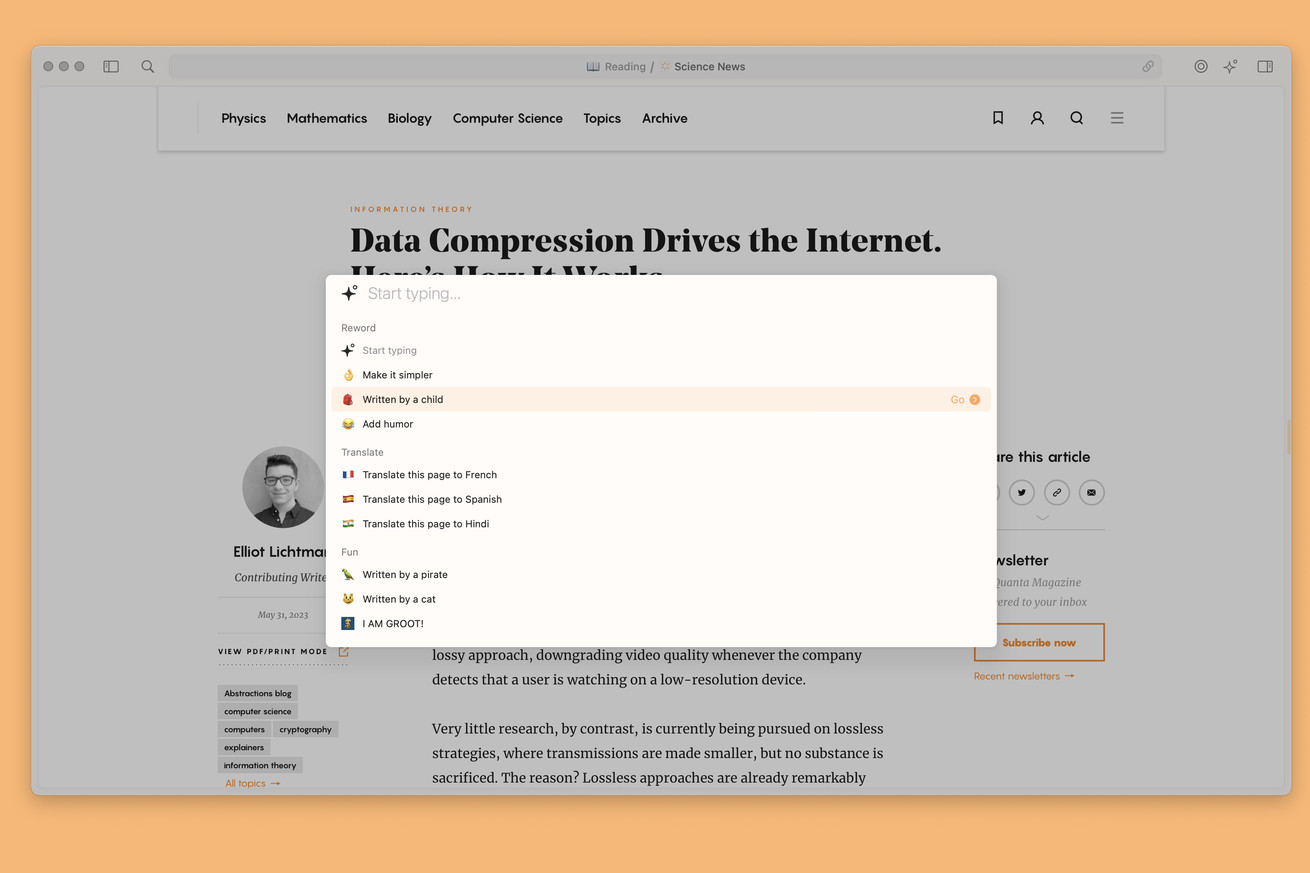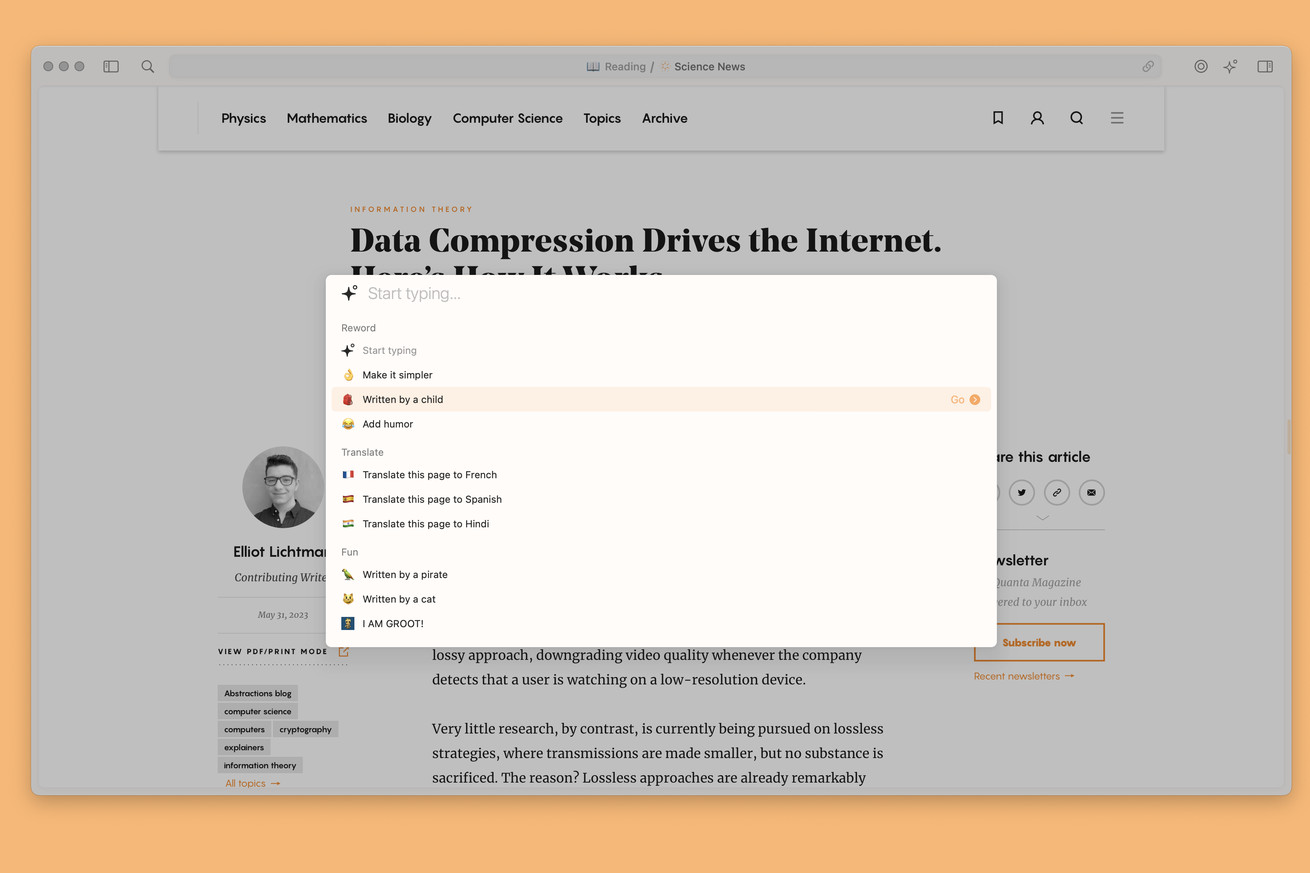
The AI revolution is about to take over your web browser
AI assistants are shaping up to be the biggest thing in browsers since the tab was invented. Companies big and small are looking for ways to bring chatbots into your experience but also to go even deeper than that. Pretty soon, your browser might be able to automatically change the way a page looks and works and even rewrite the words on the page to suit your particular needs.
One of the most ambitious implementations I’ve seen is from a company called SigmaOS, which bills itself as a browser for the ultra-productive set. It has lots of organization tools and some truly wacky ideas about keyboard shortcuts and tab management — and now, it’s launching a new AI assistant called Airis that works across the browser. (It’s pronounced like “iris” but with AI, because you gotta have AI, you know?) What Airis does, essentially, is let you ask questions about a webpage. You can highlight a name or a phrase, right-click, and select “ask Airis” to look up whatever you’ve selected. It then attempts to explain that name, concept, phrase, or whatever in the context of the page you’re looking at.
If I were to ask, say, ChatGPT who Nikola Jokić is, I’d get an overview of the Serbian NBA superstar. But when I asked Airis about Nikola Jokić on an ESPN story previewing the NBA finals, it told me that “the author discusses how Jokic’s pick-and-roll with Jamal Murray is an almost unstoppable combination.” There are plenty of AI-based ways to summarize a webpage, but this one does it in the exact context I’m looking for. I can also ask Airis follow-up questions — who does this author think is going to win the championship? — and get answers.
“I don’t have to write a massive, complex ChatGPT prompt saying I want to create an Arrabbiata,” says Mahyad Ghassemibouyaghchi, SigmaOS’s CEO. “I can just ask. You already know the context, I don’t need to do extra.”
Because the browser knows the page I’m looking at, it can infer a huge amount of information from a simple prompt. The way Ghassemibouyaghchi describes Airis’ tech is simple and clever: it quickly ingests and understands the important parts of a webpage, pairs that information with your question to form a complex prompt, sends that prompt to OpenAI’s GPT-4 large language model, and then feeds back the responses. You don’t have to do any prompt engineering because your question plus the webpage contains more than enough information.
As he explains, Ghassemibouyaghchi shows me a demo of Airis that includes summarizing the four main points of a thinky business article and pulling the ingredients out of a very long recipe page. “What we’re doing is looking at it with our algorithm, building a hierarchy, and saying, ‘Okay, what are the most important parts for this person to understand?’ It’s like trying to explain to a five-year-old: you need to give the most important simple information, but don’t omit anything important.”
Airis can also help you edit and rewrite text, similar to the Google Duet and Microsoft Copilot tools, but because it’s built into a browser, it works with any text box on the internet. It can even rewrite existing webpages: at one point in our demo, Ghassemibouyaghchi loads the Wikipedia page for “browser wars” and clicks a menu button titled, “Make it simpler.” The page suddenly began to morph and change, shrinking fairly dramatically to make it an easier read. Like all of the Airis demos, it wasn’t perfect; it dropped some important details and turned a few sentences into gibberish. The finished product was also still pretty long. But it more or less did the job.
SigmaOS is far from the only company looking for ways to attach AI to your browsing experience. Microsoft is adding a Bing sidebar to its Edge browser, putting both search and chatbots one click away, and it’s also rolling out tools you can use to summarize or rewrite webpages. Opera recently launched its own rewriting and summarizing tools, along with a dedicated sidebar for accessing ChatGPT and other bots.
Browsers are going to be an important place for AI tools in part just because they’re so popular. Especially on desktops and laptops, most users spend most of their time in a browser. If you just build an easily accessible chatbot like Microsoft is doing with the new Edge sidebar, there’s a good chance people will find it.
But browsers also have unparalleled access to everything you’re doing, reading, watching, looking at, and typing all over the web. That means browser-level AI could be more capable than almost any other tool. “You need to be able to move smoothly between one service and another,” says Krystian Kolondra, Opera’s EVP of PC and gaming. “Take this spreadsheet, make a presentation out of it with AI. All the services are available through the browser, and AI could be a glue.”
This is all easier said than done, though. There are huge privacy concerns when it comes to sending your browsing history to GPT-4 or any other model, not to mention the costs incurred every time you say, “Make this massive webpage shorter.” The web is fast, but AI is slow, which is a tricky UI problem. And as seemingly every search engine and app adopts AI features of its own, how do the bots interact with each other?
Reinventing the browser is hard work, too. (Remember how much people freaked out when Apple moved the Safari URL bar from the top of the screen to the bottom?) But it’s a ripe moment for innovation. The last few years of pandemic work-from-home life made PCs matter again in new ways, and desktop browsers are the most important app on most people’s computers. Developers and regulators are increasingly frustrated with app stores and cross-platform life, which means web apps are having a moment. And maybe most of all, browser makers are finally realizing that managing all your tabs sucks, and they need to do something about it.
There’s plenty left to figure out, but AI seems like it might ultimately change everything about how browsers work. For so many years, browsers have looked the same practically no matter which app you use: row of squared-off tabs at the top, big address bar underneath, maybe some extensions off to the right, row of bookmarks below. Back, Forward, Refresh buttons. Not much else. But now, as AI connects services and works across them, our relationships with our tabs may be about to change.

